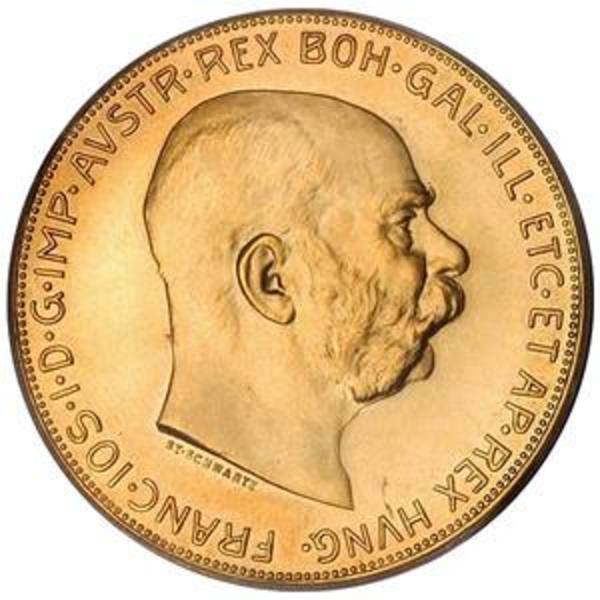Austrian Gold Coins
Learn More About Austrian Gold Coins

Austrian gold coins are an excellent way for collectors to connect with history while investing in tangible assets like gold. These coins are known for their historical significance and intricate designs minted by the Austrian Mint over various periods.
Due to their gold content, these coins are highly valued both as numismatic collectibles and as investments. Some of the most famous vintage Austrian gold coins include the Ducat, the Corona, and the Schilling.
Austria's history of gold coins as currency dates back to the medieval period, but a more structured use began with the minting of the Ducat in 1612. The Ducat was used extensively throughout the Austro-Hungarian Empire and became one of Europe's most respected gold coins due to its consistency in gold content and purity.
In 1892, Austria introduced the Corona as part of a currency reform following the Latin Monetary Union's system. The gold Corona coins, particularly the 100 and 20 pieces, were issued to mark Emperor Franz Joseph I's 60th year of reign in 1908 and were inscribed with his likeness. Collectors and investors still seek the 100 Corona coins.
After World War I, the Austro-Hungarian Empire dissolved, and the subsequent Austrian Republic continued to use the Corona until 1924. It was then replaced by the Schilling, which was also minted in gold briefly until World War II made gold coins impractical for regular use.
Austrian gold coins are popular among investors for their historical value, low premiums, and high gold content.
Austrian Gold Coronas
The Austrian Gold Corona was first minted during the reign of Emperor Franz Joseph I (1848-1916). These coins are prevalent due to their historical significance and attractive designs.
Specifications:
- Weight: 13.76 grams (0.44 troy oz) for the 100 Coronas.
- Purity: 90% gold (21.6 karats).
- Diameter: 37 mm.
- Design: The obverse features a portrait of Emperor Franz Joseph I, while the reverse shows the Austrian coat of arms with a crowned imperial double-headed eagle.
- Minting: The most common year for 100 Corona restrikes is 1915, although restrikes are still produced today.
The 100 Corona is the most well-known, though smaller denominations exist.
Austrian Gold Ducats
First issued in the 17th century, the **Austrian Gold Ducat** is known for its thin, large diameter and is still produced as a restrike. Ducats are favored for their purity and affordable premiums over spot prices.
Specifications:
- Weight: 3.44 grams (0.11 troy oz) for the 1 Ducat.
- Purity: 98.6% gold (23.75 karats).
- Diameter: 20 mm (1 Ducat).
- Design: The obverse displays a portrait of Emperor Franz Joseph I, and the reverse features the Austrian imperial eagle.
- Popular Denominations: 1 Ducat and 4 Ducats.
- Notes: The 4 Ducat has a much larger surface area and weighs 13.76 grams.
Austrian Gold Florins
The Florin (or Gulden) was an official Austrian currency in the 19th century. Due to their historical importance and design, Gold Florins are still popular with investors.
Specifications:
- Weight: 3.2258 grams (0.104 troy oz) for the 10 Florins.
- Purity: 90% gold (21.6 karats).
- Diameter: 19 mm for the 10 Florins.
- Design: The obverse features a bust of Emperor Franz Joseph I, while the reverse shows the Austrian coat of arms.
- Popular Denominations: The 10 Florin and the 20 Florin are the most common.
- Minting: These coins were minted from 1870 to 1892 and are available as restrikes.
Austrian Gold Schillings
The Gold Schilling coins were minted only in 1979 and are less common, but offer investors a way to own more modern Austrian gold coinage.
Specifications:
- Weight: Varies based on the denomination.
- Purity: 90% gold (21.6 karats) in most cases.
- Design: These coins usually feature Austrian cultural symbols, such as the Austrian eagle and various prominent figures or national emblems.
- Popular Denominations: The 25 Schilling and 100 Schilling gold coins are among the most recognized.
Why Are These Coins Popular with Investors?
Each of these coins has significant historical importance, particularly those from the era of the Austro-Hungarian Empire. Many are available as restrikes that are more affordable for investors while retaining their high gold content.
Austrian gold coins, especially with Ducats, have some of the highest purities available, making them a good choice for those who prefer nearly pure gold.
Austrian gold coins often carry reasonable premiums in the secondary market due to their recognition and historical significance.
Rare and Valuable Austrian Gold Coins
The original, non-restrike versions of the Ducats, Florins, and Coronas are valuable among these coins, particularly those from limited mintages or in excellent condition, and can fetch higher premiums among collectors.











